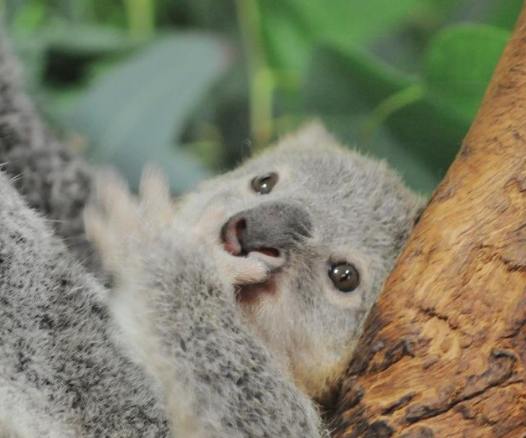I CAN’T BEAR
IT ANY LONGER!
Australia’s iconic animal, the Koala Bear – oops! I did it.
I called him a bear. He’s not, you know. I will take a leap and assume that
this error would not bother the Koala. They wouldn’t mind. However, if you go
to Australia, do not, and I emphasis that, DO NOT, refer to the Koala as a
bear. Okay, now that we’re past that, let’s explore where the name Koala Bear
originated. It’s really quite simple.
A man named John Price was the first European to record
Koalas. In 1816, the Koala was given a scientific name; phascolarctos cinereus (that’s a mouthful), which means, ‘a grey
pouched bear.’ Soon enough, it was discovered that the Koala is not a bear at
all, but the name kinda stuck. Seems an old habit dies-hard even when you’re giving
animals scientific names.
Let’s meet the Koala.
Photo Credit: Author’s own collection
Koalas are marsupials.
We’ve met a number of different marsupials on this blog, but along with the
Kangaroo, this is the one marsupial
most people are familiar with. Just to remind you, a marsupial is an animal
whose young are born incompletely developed. Those incompletely developed
young, which are about the same size, and look like a pink jellybean, find
their way to their mother’s pouch after birth. In their mother’s pouch, they
are suckled (drink milk) until they
are mature.
Photo Credit: JMB Photography via Zooborns
They stay safe in their mother’s pouch for about
six months. Then they poke their little heads out and begin life outside their
mom, usually clinging to their mother’s chest. They’re little tummies are not
yet ready to eat eucalyptus leaves, which is the only food a Koala will eat. Eucalyptus leaves are very toxic, but
Koalas have found a way to digest them, but the joeys just can’t start chewing
when they emerge from mom’s pouch. They’re mother has to feed them a yucky goo
that is called pap. I’m not going to get too graphic about this, but I will say
it’s green poop that helps the Joey’s tummy adjust to their diet of eucalyptus
leaves. Well, let’s move on from that.
Here’s a video that sums it up a lot of information about
the Koala.
Koalas are picky eaters. Although there are over 700 species
of eucalypts in Australia, the Koala likes only 120 of these species. They get
most of the moisture they need from the leaves themselves, and since their main
diet is leaves, they rarely come to the ground, unless they spy a tastier leaf
on a nearby tree. They have two thumbs on their front paws, which make them
very good climbers. They also have a ‘grooming’ claw on their hind paws, which
helps them to remove ticks.
Front Paws
Hind Paws
Photo Credit: Phillip Wright
The IUCN* lists the Koala as ‘least concern.’ However,
Australians consider their icon to be vulnerable and are taking steps to help
protect them. The efforts to protect the Koala are different depending on the
area in which the Koalas are living. Many Koalas are killed each year by cars, dogs
and forest fires. There are also concerns about logging, which takes down the
trees that are home to Koalas. Then there’s mining, which has had a
serious effect on them, causing habitat destruction.
To learn more about the Koala visit the sites listed in
Citations and References.
I hope you have enjoyed this week’s look at the Koala. My
thanks to Arkive for pictures and information. Please come back next week, and
be sure to share my site with your friends, especially the young ones.
Enjoy!
Jeanne E. Rogers, Author
The Sword of Demela
An Award Winning Middle Grade Fantasy Where Endangered
Animal Heroes Roam the Pages!
*IUCN: International Union for the Conservation of Nature
Citations and References:





